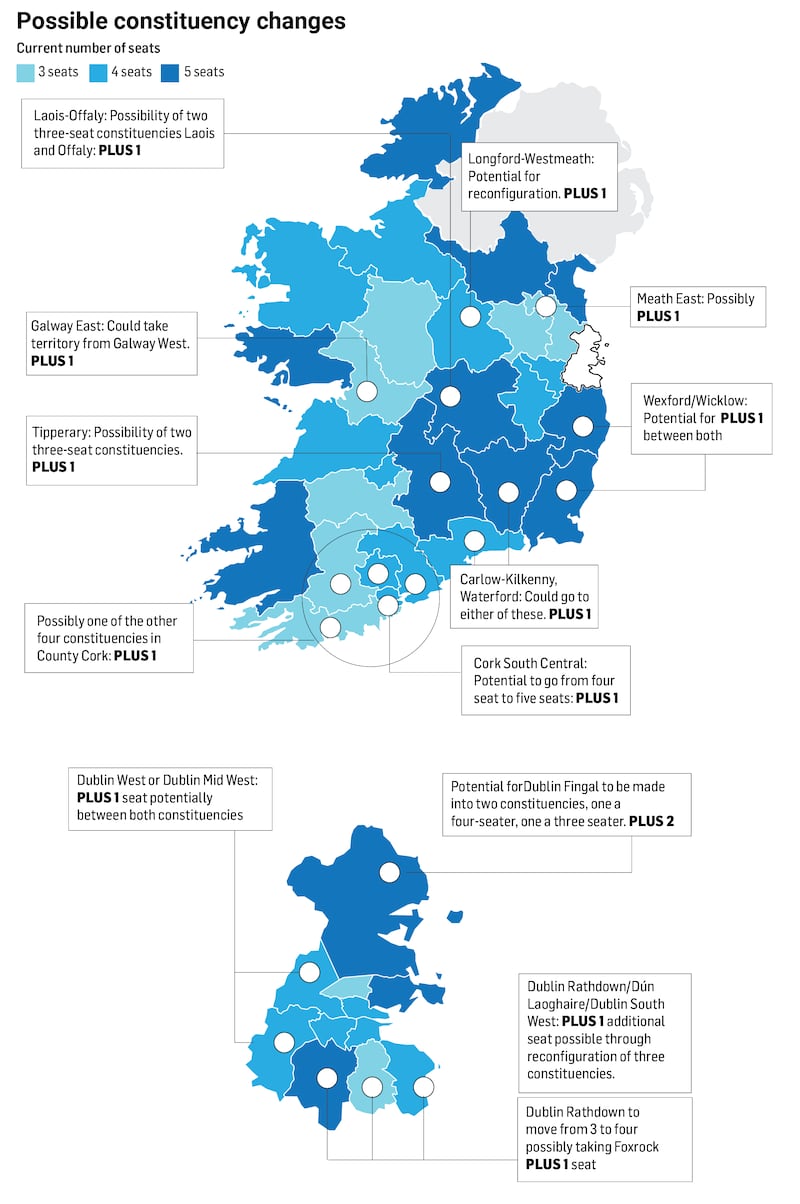If you were looking for a constituency that neatly mirrors one of the more straightforward analyses of Irish politics, Donegal would tick a lot of boxes.
The mainstream parties are a shadow of their former selves, eeking out seats against the backdrop of a rampant Sinn Féin vote and Independents picking up on the margins. The smaller centre-left parties do not feature.
[ Donegal: Full Election 2020 results breakdown, story of the count and profiles Opens in new window ]
Donegal comes into focus this week when the Electoral Commission review, setting out how the country’s electoral map might be reshaped, is published on Wednesday.
A growing population means that all but one of the 39 general election constituencies has more than 30,000 people per TD, when the Constitution says there must be one Dáil representative for every 20,000 to 30,000 people.
READ MORE
The commission’s review will increase the overall number of TDs and change the general election map.
Donegal is a five-seater but with a number of southwestern electoral divisions hived off into the Sligo-Leitrim constituency. The population in Donegal has grown to such an extent that the county could once again be allocated six Dáil seats. This would mean a split into two three-seat constituencies.

Crime on the public's mind, politicians brace for constituency reform
As things stand, the odds favour a strong Sinn Féin result. Some 45 per cent of first preference votes here went to the party in 2020, well ahead of its strong national showing of 24.5 per cent.
Indeed, anything less than Sinn Féin retaining two of five seats would be an abject failure for the party, which would target four seats from two three-seaters, or three if the constituency lines remain the same.
Locally, some feel party whip Pádraig Mac Lochlainn could be squeezed in a new Donegal North-East by a candidate running on the platform of Mica defects, given the prevalence of the issue on the Inisowen peninsula and surrounds.
This could potentially eat into Sinn Féin’s strong share of the anti-Government vote, but the issue is probably not quite as potent as it was two years ago. Mac Lochlainn would have to seriously underperform, but a strong Mica-focussed candidate could make him sweat
Pearse Doherty’s running mate in a renewed Donegal South-West could be former councillor Cora Harvey, whose strong base in her Finn Valley heartland is already guaranteed for the party. Mac Lochlainn would likely be joined on a North-East ticket by Maria Doherty.
Even as a sitting Minister, Fianna Fáil’s Charlie McConalogue’s hopes — more so in a reconstituted Donegal North-East than in a five seater — would likely rest on sufficient progress being made with, and support being found for, the Mica redress scheme. Some mischievous briefing suggests that McConalogue could face a challenge from within via Cllr Ciarán Brogan.
In a renewed South-West constituency, the veteran name of Pat The Cope Gallagher crops up when it comes to Fianna Fáil. He is said not to be disabusing anyone locally of the notion that he could make a return to national politics, although there are other options, with Cllr Michael Naughton mentioned.
Fine Gael is facing an uphill battle to retain the seat held by Joe McHugh, who lost the whip over Mica and is not standing for election again. The party is said to be courting businesspeople in Letterkenny on the thesis that a strong vote in the big town could power a candidate home, but constituency veterans say the town rarely votes as a bloc.
If Bundoran and Ballyshannon are to become part of a Donegal South-West constituency, Cllr Barry Sweeny is seen as a strong candidate or, under the existing boundaries, Ballybofey businessman Cllr Martin Harley is mentioned.
Thomas Pringle would not be hurt by the return of the two towns and could complete a very left-leaning Donegal South-West line-up, though The Cope Gallagher would be hard to discount if on the ticket.
Current state of play: Where Donegal stands
Constituency: Donegal.
Current number of seats: Five.
Sitting TDs: Pearse Doherty (SF), Pádraig Mac Lochlainn (SF), Joe McHugh (FG), Charlie McConalogue (FF), Thomas Pringle (Ind).
Population Census 2016: 150,657.
Population Census 2022: 156,990 (+4.2 per cent).
Population per Dáil member 2022: 30,131.
Issues on the ground: Mica and redress above all else. Brexit and cross-Border concerns linger, along with national issues.
Lay of the land: The future of the south Donegal towns of Ballyshannon and Bundoran, part of the Sligo-Leitrim constituency since 2016, will be key.

Options: Bringing the two towns back into Donegal would add just under 5,000 to the population, making two mid-sized three-seaters on the old footprints of Donegal South-West and Donegal North-East a runner. But of course, there would be knock-on effects on the whole midlands-northwest chessboard.
Another option would be to extend Sligo-Leitrim further into Donegal, shrinking the population of the current constituency and right-sizing it to the five-seater template.
This would likely prove extremely unpopular with voters in south Donegal, with several submissions to the electoral commission, both from residents of these areas and sitting TDs representing them in Sligo-Leitrim, outlining feelings of disenfranchisement — not to mention running contrary to the aim of respecting county boundaries.



















